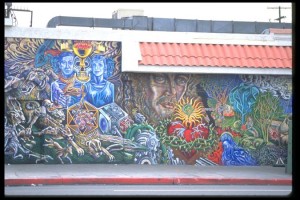The last mural I visited was The Greatest Love painted by Paul Botello in 1992 located on the corner of Cesar Chavez and Soto Blvd in East Los Angeles. The Greatest Love has various images and symbols that all tie together to form a uniquely dark and Chicano mural. Interestingly enough, the adjectives describing the mural could very well describe the neighborhood around it. The setting of the mural and the surrounding area takes on a similar form as that in Their Dogs Came With Them. For me, when I was reading the novel, I was picturing the scenes happening in the very neighborhood of this mural. Across the street from the mural, there are panaderias, mercaditos, and plenty of Mexican restaurants; similar to the locations that many of the characters had encountered in their neighborhood of East Los Angeles.
This mural has interesting historical context tied along side it as well. The Greatest Love was in fact a response to the LA Riots of 1992. Although the riots, for the most part, occurred in the communities of south LA, East LA experienced much of the same emotions since it is predominantly racial minorities as well. After the riots, the city of Los Angeles commissioned muralists to have work done in various communities in South LA and the Eastside. The purpose was to depict the culture and history of each particular neighborhood. This particular mural by Botello was done during the aftermath of the riots, however was a gift to the neighborhood from the pharmacy that the mural is painted on.
This mural contains many images, each conveying various messages. For starters, the image the eye is drawn to first, in my case, is the heart wrapped around a vine of thorns in the right panel. The heart seems to be under duress by the force of the seemingly constricting vine, as if it was crushing the life out of the heart, but nevertheless it perseveres and sprouts a yellow flower. After learning that the mural was, in part, a response to the LA riots, I understood this image as the heart representing the neighborhood and surrounding communities, and the vine as adversity, hate, and ignorance from society. Through it all, the neighborhood endures and proceeds to give new life adding to its culture and history.
The Greatest Love also contains gothic elements as well, mostly residing in the left panel. Numerous skeletal, dark images cover most of the panel, giving it obvious gothic characteristics. An interesting aspect of this panel is the two distinguishable figures. After not realizing these people at first, I remembered that the mural is on Cesar Chavez Ave. So I researched images of him and found the similarities between Cesar Chavez and co-founder of the UFW, Dolores Huerta, with the two figures in the mural. Chavez is seen gripping a snake by its head, which to me seems as if he is displaying his fearlessness and bravery to tackle the adversities of society. The two figures can be seen standing upright with great conviction with crowns placed above their heads and looking ahead into the future, not paying attention to the bad temptations and evil figures behind them in the past that strive to steer the two off their mission.
The depiction of the animals also ties the Chicano to the gothic. The jaguar is an animal generally depicted in Aztec imagery, which often represents the reverence for nature. The manner in which the jaguar and the other animals are depicted is in a way where they give off a darkness and gothic feeling. The overall dark and skeletal appearance of the images in this panel gives the mural the gothic additive.
The Greatest Love represents many things. It represents the neighborhood of Boyle Heights. It represents the community of East Los Angeles. It represents Chicanos and it represents the feelings immediately following the LA Riots of 1992. All in all, the imagery and symbolism contained in the mural convey messages aimed towards the empowerment of the community and the reminder of the significance of figures like Cesar Chavez and Dolores Huerta all while providing gothic elements intended to represent the darkness and turmoil that the neighborhoods had endured over the years.
Work Cited: Botello, Paul. “Mural Conservancy of Los Angeles.” The Greatest Love. Web. 29 Apr. 2014. http://www.muralconservancy.org/murals/greatest-love




